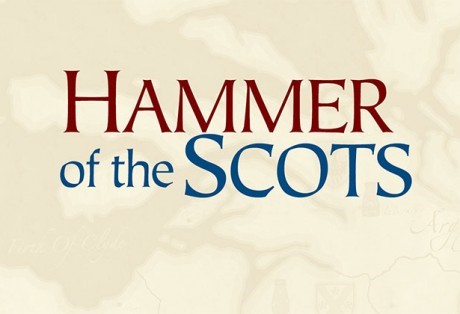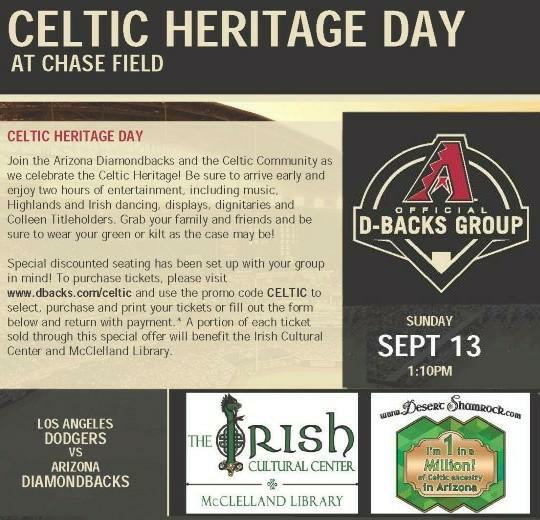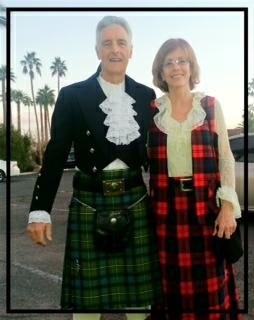
6:30 - 7:30
Social Hour
7:30 - 8:30
A History of Scortland -Episode 2
8:30 pm
Raffle and 50/50 draws
We will continue with the BBC video series - A History of the Scots
Episode 2 - Hammer of the Scots
Neil Oliver charts the 13th century story of the two men who helped transform the Gaelic kingdom of Alba into the Scotland of today. While Alexander II forged Scotland in blood and violence, William Wallace's resistance to King Edward I of England hammered national consciousness into the Scots.
Introduction by CS member Dave Patterson
Free Admission with donation to St. Mary’s Food Bank

Peanut Butter, Canned Vegetables or Fruit, Rice, Pasta, Beans
Any non-perishable food items. No glass please.
Letter from Editor, Don Finch
Dear fellow Caledonians,
.jpg) Happy Lammas! August 1 is Lammas Day in Scotland, the festival of the wheat harvest, and is the first harvest festival of the year. On this day it was customary to bring to the church a loaf made from the new crop, which began to be harvested at Lammastide. The third of the Scottish Quarter Days Lammas perhaps had begun as a celebration of the Celtic goddess Lugh, and was absorbed into the church calendar as Loaf Mass Day. Lammas takes its name from the Old English half, meaning “loaf”. Happy Lammas! August 1 is Lammas Day in Scotland, the festival of the wheat harvest, and is the first harvest festival of the year. On this day it was customary to bring to the church a loaf made from the new crop, which began to be harvested at Lammastide. The third of the Scottish Quarter Days Lammas perhaps had begun as a celebration of the Celtic goddess Lugh, and was absorbed into the church calendar as Loaf Mass Day. Lammas takes its name from the Old English half, meaning “loaf”.
August 5th is another feast day –the California Pizza Kitchen at 1850 S Val Vista in Mesa (Dana Park Shopping Center) is donating 20% of your check to the Caledonian Society’s Highland Dance competition to help offset the cost of renting a new dance floor and other competition-related expenses. Please join us next Wednesday for this fun and worthwhile event, and, wear the kilt! Print your coupon.
The 2016 Scottish Gathering & Highland Games are approaching, and beginning with this issue of the Desert Highlander, Games Chairman Paul Bell will provide a monthly update on preparations for next year’s main event.
 I hope you’ll find interesting the articles on the origin of the McIntosh apple, The Stone of Scone, what it’s like living in St. Andrews, Scotland, the upcoming Celtic Heritage Day at Chase Field, and the source of the name ‘Phoenix’ (did you know it was Scottish?)
I hope you’ll find interesting the articles on the origin of the McIntosh apple, The Stone of Scone, what it’s like living in St. Andrews, Scotland, the upcoming Celtic Heritage Day at Chase Field, and the source of the name ‘Phoenix’ (did you know it was Scottish?)
Enjoy the read. Hope to ‘have a slice’ with you at CPK on August 5th!
Slainte! DON |
|
A Walk Through St. Andrews
On the west coast of Scotland in the Kingdom of Fife, nestled along the staggering 6100+ miles of coastline, you’ll find the tiny town of St Andrews facing the North Sea. The town is generally known for one of two things –the birthplace of golf or for the oldest University in the country (where a certain prince met a certain Middleton) that recently celebrated it’s 600th birthday.
.jpg)
Depending on whom you talk to, it’s a fair wager that you’ll stick to one of three main streets – North Street, Market Street or South Street – while you’re visiting the town. These three streets meet at a point on the east side of town at the stunning cathedral ruins that abut East Sands.
.jpg) If you stroll through what remains of the 12th century marvel (destroyed during the Protestant Reformation), you’ll find the iconic pier where students are known to walk in their red academic gowns on Sundays. Head west along the Scores and you’ll find yourself first at the Castle ruins and then West Sands on the other side of town. Yes, this tiny town has two beaches to explore and yes, you just walked the length of the town in 30 minutes! If you stroll through what remains of the 12th century marvel (destroyed during the Protestant Reformation), you’ll find the iconic pier where students are known to walk in their red academic gowns on Sundays. Head west along the Scores and you’ll find yourself first at the Castle ruins and then West Sands on the other side of town. Yes, this tiny town has two beaches to explore and yes, you just walked the length of the town in 30 minutes!
It’s along West Sands that you’ll find the Old Course and golfers of any given nation. Head southeast back towards town and you’ll notice the golf shops give way to a surprising number of hotels, restaurants and charity shops. With at least half of the population enrolled at uni, you also may experience a number of unusual traditions.
.jpg) In the fall, keep an eye out for Raisin Weekend celebrations where participants must complete scavenger hunts, dress in costumes of varying degrees of shame and that culminates in a massive foam fight in St Salvator’s Quadrangle. In the fall, keep an eye out for Raisin Weekend celebrations where participants must complete scavenger hunts, dress in costumes of varying degrees of shame and that culminates in a massive foam fight in St Salvator’s Quadrangle.
Or in the spring, bear witness to the May Dip in which students plunge into the North Sea before dawn for good luck on exams or to assuage stepping on the dreaded PH, a symbol said to guarantee students will fail their degree entirely.
.jpg) Alicia Chavez joined the Caledonian Society of Arizona in 2013 after deciding to move to Scotland for a year to complete a Masters degree at the University of St Andrews. Alicia Chavez joined the Caledonian Society of Arizona in 2013 after deciding to move to Scotland for a year to complete a Masters degree at the University of St Andrews.
It should be noted that she found the Society online and had no idea what she was doing. For a lifelong sun-loving desert dweller she sure does miss that gorgeous little green country.
|
|
2016 Highland Games Update - Paul Bell, Chairman
 We are in the early stages of preparation for the 2016 Scottish Gathering and Highland Games!! But we are in high gear already! With that said we are in need of your help! The help of our membership who make our event the premier event in Arizona and one of the top events in the Southwest! We are in the early stages of preparation for the 2016 Scottish Gathering and Highland Games!! But we are in high gear already! With that said we are in need of your help! The help of our membership who make our event the premier event in Arizona and one of the top events in the Southwest!
It takes involvement and time and effort to make our event a success and that is where we need your help!
We have a few positions that we need to fill for the 2016 Games:
Volunteers – This person is responsible for:
- 1. Helping to recruit volunteers (There are already several contacts lined up to draw from)
- 2. Creating a sign in/ sign out procedure
- 3. Creating a schedule for Friday, Saturday and Sunday and Monday for as many volunteers as possible (work with other Chairs to obtain numbers of volunteers they will need in their areas
- 4. Monitoring volunteer break area, order food and arrange for pick up or delivery
- 5. Making sure each volunteer has a “VOLUNTEER” T shirt and wears it during the event
- 6. Responsible for set up and tear down of volunteer area.
Information – This person will see to it that:
- 1. Each Area Chair has provided them with pertinent information about their section
- 2. Everyone working in the tent is informed about the games, has reviewed the program, event layout and individual area layouts
- 3. Everyone is informed about the CSA including membership, annual events and that everyone is PLEASANT and treats our guests with respect.
- 4. The area is set up and torn down.
Merchandising – This person will:
- 1. Oversee the CSA merchandise area (to be located by the Pub tent)
- 2. Be aware of what items are being sold in the booth, create an attractive display area
- 3. Assist in research and selection of items to be sold
- 4. Be sure that everyone is PLESANT and treats our guests/ customers with respect.
- 5. Oversee set up and tear down of area
Decorations – This person will:
- Oversee decoration of Chief’s golf cart and tent (located in Clan area) Other areas as deemed necessary by Games Chair and/ or Jackie Carro (Marketing)
If you are interested in taking the lead as an Area Chair in, or working in, any of these areas please get in touch with me!! gameschair@arizonascots.com
Again, this event will need your help, so please consider stepping up to help out the weekend of March 18-20, 2016.
|
|
Burns Supper - January 23, 2016

We’re returning to the Phoenix Country Club to
celebrate the life and works of Robert Burns.
Vicki Phegley, Burns Committee Chair is looking for volunteers to assist.
Contact her at: vickimunro@outlook.com
"Whenever someone asks me if I want water with my scotch, I say 'I'm thirsty, not dirty'" Joe E. Lewis
|
|
Tesco Abandons Plan to Rename Tattie Scones After Backlash
From: The Scotsman July 26, 2015
.jpg) TESCO have ditched plans to rename ‘tattie scones’ as ‘potato scones’ after complaints from Scots customers. TESCO have ditched plans to rename ‘tattie scones’ as ‘potato scones’ after complaints from Scots customers.
The supermarket giant had repackaged the Scottish breakfast favourite as ‘potato scones’ in its stores north of the border. However, the move earlier this month upset Scots who contacted bosses to ask them to change the name of the product back to ‘tattie scones’.
Margaret Cooper, 64, from Bo’ness, West Lothian, contacted Tesco by email after she noticed the change in name at her local supermarket.
She said: “Tattie scones is the name everyone uses for this food item and there’s no reason why the name should be changed. I contacted Tesco to complain and they sent me an email telling me they were looking into it. I mentioned it on Facebook and a number of my friends also wrote to the store. I was surprised but pleased to receive a call to say that Tesco had taken on board my complaint and would change the name of the product to ‘tattie scones’ in the next two weeks.”
David Bitchell wrote on Twitter: “Tesco have started calling there tattie scones potato cakes/scones and have the cheek to put a saltire on them. [sic]
“I’m no’ even kidding am raging about this - best way to subdue people is by taking away there language.” [sic]
The u-turn has also been welcomed by campaigners for the Scots language.
Michael Hance, Director of the Scots Language Centre, said: “I’m really glad to hear Tesco has responded to customer pressure.
.jpg) “’Tattie’ is a perfectly respectable Scots word used by people across the country. I’ve never heard anyone call this product ‘potato scones’. “’Tattie’ is a perfectly respectable Scots word used by people across the country. I’ve never heard anyone call this product ‘potato scones’.
“This is not the time to say tatty bye to the tattie scone and Tesco has done the right thing.”
|
|
Scottish Historical Events in August
by Jo Ramsdell
August 8, 1296 - The Stone of Scone
The Stone of Scone—also known as the Stone of Destiny—was used for centuries in the coronation of the monarchs of Scotland and later the monarchs of England. Historically the artifact was kept at the now-ruined Scone Abbey in Scone, near Perth, Scotland.
.jpg) Various theories and legends exist about the Stone’s history prior to its placement in Scone. One story says Fergus, son of Erc, the first King of the Scots in Scotland transported it from Ireland to Argyll, where he was crowned. Legend s place the origins of the Stone in Biblical times and consider the Stone to be the Stone of Jacob or Jacob’s Pillow. Various theories and legends exist about the Stone’s history prior to its placement in Scone. One story says Fergus, son of Erc, the first King of the Scots in Scotland transported it from Ireland to Argyll, where he was crowned. Legend s place the origins of the Stone in Biblical times and consider the Stone to be the Stone of Jacob or Jacob’s Pillow.
On August 8, 1296 the Stone was captured by King Edward I as spoils of war and taken to Westminster Abbey, where it was fitted into a wooden chair—known as King Edward’s Chair—on which most subsequent English sovereigns have been crowned.
On Christmas Day 1950 the Stone was stolen by a group of Scottish students. The Stone was broken into two pieces during the removal. It was returned briefly to Scotland but was found in April 1951 and returned to England and professionally repaired by a Glasgow stoneman.
In 1996 the British Conservative Government decided the Stone should be kept in Scotland when not in use for coronations. The Stone now resides in Edinburgh Castle along-side the crown jewels of Scotland.
|
|
Save the Dates - Celtic Heritage Day - 2016 Games & Gathering


|
|
Coming
Western US & Canada Highland Games
|
Origin of the Name: Phoenix
Recorded in a number of spellings including Fenwich, Fenwick, Fennick, Finnick, Vinnick, and the extraordinary dialectals Phoenix and Phonix, this very early surname is Anglo -Scottish from the region known as "The Border Country". This was for centuries an area of total anarchy, and where it has to be said, the "clan" Fenwick played a prominent part!
The surname is locational and when English derives either from the villages of Fenwick in Northumberland, near Kylow and Stamfordham, or if Scottish from the village of Fenwick in the county of Ayrshire. There is also a village called Fenwick in the West Riding of Yorkshire, but it is unclear whether this produced any surname holders.
What is certain is that with all the villages’ names and hence the surname, the translation is the same. The name derives from the Olde English pre 7th Century "wic" meaning a dwelling place, or a dairy farm, or sometimes a landing place. To this prefix is added "fen" meaning a marshland, or water meadow.
The surname is first recorded on the Scottish side of the "Border Country", (see below), and almost all early surname recordings are from this region. These early recordings include Thomas de Fenwyk, a witness at the 1279 Assize Court of Northumberland, and Nicholas Fynwik, who was the provost of Ayr, Scotland, in 1313. Sir John Fenwick, born in 1579, was High Sheriff of Northumberland in 1658, in the 'reign' of Oliver Cromwell. The first recorded spelling of the family name is shown to be that of Robert de Ffenwic, which was dated c.1220. He was a charter witness, and is so recorded in the rolls of the Abbey of Kelso.
Throughout the centuries, surnames in every country have continued to "develop" often leading to astonishing variants of the original spelling.
|
|
The MacIntosh Apple
From Apples, by Roger Yepsen. Published by W.W. Norton & Company
McIntosh is the best-selling apple in the northeastern United States and in Canada. Unlike Red Delicious, the number one North American variety, it isn’t the subject of snide remarks by apple aficionados.
 John McIntosh, a Scottish-Canadian farmer in Dundela, Dundas County, Ontario gave his name to a talented cross between Fameuse and Detroit Red. The variety was introduced in 1870 and went on to much fame and much cross- breeding. McIntosh has lent its good genes to several well-known varieties, including Cortland, Empire, Macoun, and Spartan. John McIntosh, a Scottish-Canadian farmer in Dundela, Dundas County, Ontario gave his name to a talented cross between Fameuse and Detroit Red. The variety was introduced in 1870 and went on to much fame and much cross- breeding. McIntosh has lent its good genes to several well-known varieties, including Cortland, Empire, Macoun, and Spartan.
The original tree was badly scorched when a fire burned down the McIntosh farmhouse in 1894. But the old Mac limped on, yielding its last crop in 1908. It fell over two years later and a stone memorial now marks the site.

The apple, in case you haven’t visited your supermarket’s produce section lately, has white, tender, crisp flesh that’s spicy, highly aromatic, and full of juice. The characteristic flavor carries over into sauce, but in a pie loses their shape. Macs are the principal cider apple in the Northeast.
Harvest is September. Beware of McIntosh as winter wears on; the apples are not at their best if stored too long.
========================================================
McIntosh apples are available in the Phoenix area at Sprouts, beginning late September. (Editor) |
|
Upcoming Events and Celebrations
If you would like your special date recognized in our monthly newsletter, we need to hear from you. Please let us know your correct birthday and anniversary information by email to anjrams@cox.net and it will be included in our Celebration list.
| August 5 |
Highland Dance Fundraiser |
| August 13 |
Monthly CSA Meeting |
| August 29 |
Steve and Gail Wylie -Anniversary |
| Sept 10 |
Monthly CSA Meeting |
| Sept 13 |
Celtic Heritage Day at Chase Field |
| Nov 7-8 |
Tucson Highland Games |
|
|
Meet the Members - Mary Reace and Robin Lowe

Mary Reace and Robin Lowe met in Cairns, Australia, in 1998 where they began playing Celtic music together.
Married in Hot Springs in 2001, they finally came "home" to Arizona in 2011 where they perform at the Irish Center, Highland Games and weekly music sessions.
As Scottish descendants, they love the Caledonian Society activities and the terrific members who appreciate donning their tartans!
|
|